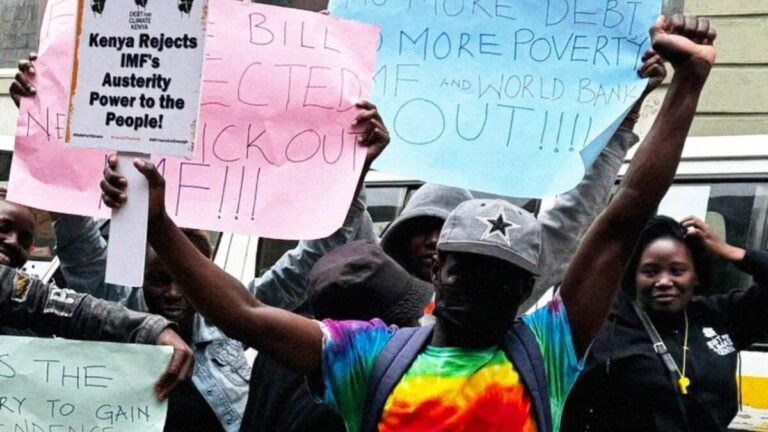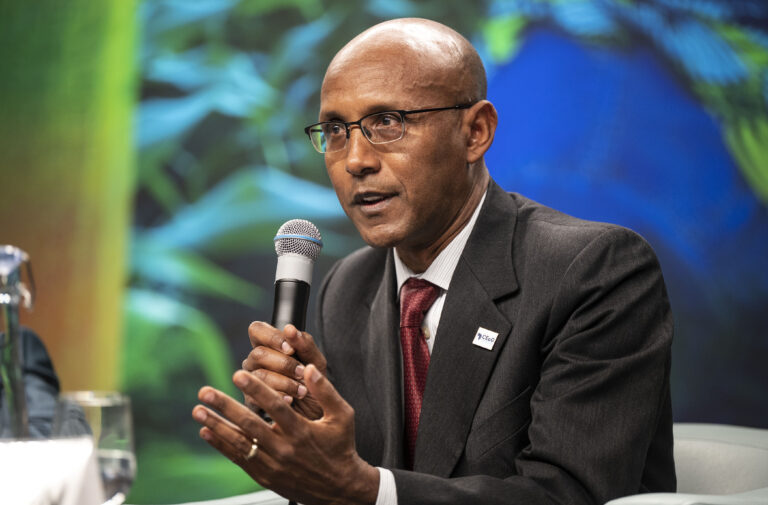
Uganda AIDS Commission officials, youth advocates, and community leaders rally behind adolescent-focused HIV prevention efforts at a public awareness event. (Photo/UAC).
By Daisy Okiring and Ochoggia Abdallah
When the United States imposed a 90-day freeze on foreign aid in early 2025, it sent shockwaves through Uganda’s healthcare system. The freeze threatened to undo decades of progress in the fight against HIV/AIDS, a disease that still afflicts over 1.4 million Ugandans. But as funding dwindled, Uganda’s AIDS Commission responded with urgency, crafting a new roadmap focused on sustainability, integration, and local ownership.
For Uganda, the stakes couldn’t be higher. The country has reduced its HIV prevalence to 5.1%—a marked decline from 18% in the 1990s. Yet in 2024 alone, Uganda recorded 38,000 new infections and 19,000 AIDS-related deaths. Even more alarming: 4,700 babies were born HIV-positive.
“This is not just a health crisis,” said Dr. Nelson Musoba, Director General of the Uganda AIDS Commission (UAC). “It’s a social, economic, and generational issue. We must act now or risk losing our hard-earned gains.”
The Impact of the Executive Orders
The U.S. President’s executive orders halting aid under PEPFAR—the U.S. President’s Emergency Plan for AIDS Relief—left a gaping hole in Uganda’s HIV response. Each year, PEPFAR contributes nearly $350 million, accounting for 55% of all HIV-related funding in Uganda.
Also Read: Obstetric Fistula: A tragedy haunting Kenyan maternity wards
“If this funding is not realized, it could reduce availability of lifesaving antiretrovirals (ARVs) by 30%, laboratory supplies by 70%, and male circumcision kits by 100%,” reads a UAC policy brief submitted to Parliament.
More than 29,000 health workers supported by U.S. funds risked losing their jobs. That meant fewer hands to test, treat, and counsel the millions relying on public healthcare.

A health educator addresses construction workers during an HIV sensitization session in the oil-rich Hoima district. (Photo/UAC).
Government Response: Toward a Sustainable Model
The crisis prompted a swift response. In coordination with Parliament, the Ministry of Health, and civil society groups, UAC accelerated efforts to transition from donor dependence to domestically supported programs.
“We’re urging all Ministries, Departments, and Agencies to allocate at least 0.1% of their budgets to HIV interventions,” said Dr. Musoba. “This mainstreaming is now more than a guideline—it’s a necessity.”
A new draft Sustainability Roadmap, developed in consultation with stakeholders across the country, outlines a model that emphasizes integrated services and targeted outreach, especially to vulnerable groups like adolescent girls and young women (AGYW), who accounted for most new infections.
Bringing Healthcare to the People
In January 2024, the Bukedea Health Camp offered a glimpse into the power of community-driven health services. Over five days, 4,500 patients were treated, and nearly 40,000 condoms were distributed.
“This health camp was a lifeline,” said Joanita Kemigisha, UAC’s Head of Communication and Advocacy. “It’s proof that when services go to the people—not the other way around—we get results.”
Also Read: Kenya Forgotten Schools: Education in arid regions
At the camp, 82 men received voluntary medical male circumcision, and 128 women underwent cervical cancer screening. Nineteen new TB cases were detected and linked to care.

Participants from government, civil society, and youth organizations gather in Kabale after completing Adaptive Leadership training supported by Harvard Kennedy School.(Photo/UAC).
Corporate Sector Joins the Fight
In March, the Uganda National Oil Company (UNOC) teamed up with UAC and TASO to launch an HIV awareness campaign in the oil-rich districts of Hoima and Buliisa. Over 500 people were tested, and 34,000 condoms distributed.
“Our role isn’t just economic,” said Catherine Tumusiime, UNOC’s Chief Human Resources Officer. “We must protect the communities we operate in.”
Such partnerships are becoming increasingly vital as donor funding dwindles. UNOC has committed to working with Village Health Teams (VHTs) for long-term follow-up and education.

Participants gather for the national HIV/AIDS stakeholder meeting at Imperial Resort Beach Hotel. (Photo/UAC).
Reaching Hidden Populations
Despite national efforts, HIV hotspots remain, particularly in urban centers and among marginalized groups.
“In cities like Mbarara and Gulu, we’re seeing sex work masked under legitimate fronts—barmaids, massage parlors, even saunas,” said Charles Otai of UAC. “These are difficult populations to reach, but they must be part of the response.”
Age groups once considered low-risk are also emerging as vulnerable. “People aged 45–55 are engaging in risky behavior due to disposable income and strained relationships,” Otai added.
Also Read: “Who saves for death?’: Where funeral costs break families
Youth at the Forefront
In March, UAC launched Adaptive Leadership training focused on young women and girls. With support from Harvard’s Kennedy School, 101 participants from government, NGOs, and youth groups received training on implementing community-driven solutions.
“Poverty, gender-based violence, and poor access to education fuel the HIV crisis,” said Dr. Farayi Chipungu, one of the trainers. “This program teaches stakeholders to go beyond technical fixes and tackle root causes.”
Laboratories Lead the Way
The Teso Sub-region provides a model for decentralizing diagnostics. Laboratory hubs in Kaberamaido and Serere have improved disease surveillance and diagnostics for over 30 health facilities.
“These hubs are not just buildings—they’re lifelines,” said Timothy Otaala, Lab Advisor at AIC. “From Mpox to HIV, accurate diagnosis saves lives.”
With support from CDC and Uganda’s Ministry of Health, the labs ensure timely sample collection and result delivery, even in remote areas.

Health officials review lab logistics during a routine assessment at a regional diagnostic hub. (Photo/UAC).
Looking Ahead: The 2030 Goal
Despite setbacks, Uganda remains committed to the global target of ending AIDS as a public health threat by 2030. However, experts warn that achieving the 95-95-95 UNAIDS goals—95% knowing their status, 95% on treatment, 95% achieving viral suppression—requires renewed commitment.
Several districts have reported zero mother-to-child transmissions, but testing and treatment gaps remain.
“We can’t afford to pause,” said Dr. Musoba. “This is a moment for transformation—not just survival.”
The 90-day aid freeze was a wake-up call for Uganda. Yet in the face of adversity, the country is choosing resilience, reform, and renewed hope. With stronger domestic financing, community engagement, and multi-sectoral partnerships, Uganda may still have a fighting chance to #EndAIDS by 2030.



